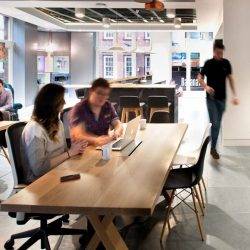April 27, 2017
London businesses lead the way in uptake of flexible working 0
 London-based businesses are leading the way in flexible working in the UK, according to a new report from conference call provider Powwownow. The study of 2,000 people claims that business leaders in the capital let their staff spend the most time working out of the office during an average week – a total of 3 hours and 31 minutes, compared to the UK average of 2 hours and 34 minutes. The survey also suggests that young people, many of whom are graduates with sought-after skills such as digital and cybersecurity expertise, are the most likely to consider flexible working a main attraction of a new job, with three quarters (76 percent) agreeing. While young people in London (18 – 24 year olds) are the most likely to want flexible working (85 percent), they are the least likely to be offered it by businesses. Over half of young people (53 percent) are not proactively offered flexible working, compared to just a third (33 percent) of 35-44 year olds who also have to ask for it.
London-based businesses are leading the way in flexible working in the UK, according to a new report from conference call provider Powwownow. The study of 2,000 people claims that business leaders in the capital let their staff spend the most time working out of the office during an average week – a total of 3 hours and 31 minutes, compared to the UK average of 2 hours and 34 minutes. The survey also suggests that young people, many of whom are graduates with sought-after skills such as digital and cybersecurity expertise, are the most likely to consider flexible working a main attraction of a new job, with three quarters (76 percent) agreeing. While young people in London (18 – 24 year olds) are the most likely to want flexible working (85 percent), they are the least likely to be offered it by businesses. Over half of young people (53 percent) are not proactively offered flexible working, compared to just a third (33 percent) of 35-44 year olds who also have to ask for it.









 London’s office workers are looking for shorter commutes, demanding more collaborative and networking opportunities while at work and better access to green space, retail, leisure and wellness; all of which could present a huge opportunity for the less congested outer London boroughs, a new report suggests. According to Savills latest London Mixed Use Development Spotlight, as employers and employees alike demand more from their workplace and their work- life balance, London’s outer boroughs could reap the benefits by providing greater flexible office space and affordable homes at a variety of price points. According to Oxford Economics, employment in sectors that tend to occupy co-working spaces is set to rise by 20,000 people in the outer London boroughs over the next five years, which equates to a gross additional need of 1.6 million sq ft (148,644 sq m) of office space.
London’s office workers are looking for shorter commutes, demanding more collaborative and networking opportunities while at work and better access to green space, retail, leisure and wellness; all of which could present a huge opportunity for the less congested outer London boroughs, a new report suggests. According to Savills latest London Mixed Use Development Spotlight, as employers and employees alike demand more from their workplace and their work- life balance, London’s outer boroughs could reap the benefits by providing greater flexible office space and affordable homes at a variety of price points. According to Oxford Economics, employment in sectors that tend to occupy co-working spaces is set to rise by 20,000 people in the outer London boroughs over the next five years, which equates to a gross additional need of 1.6 million sq ft (148,644 sq m) of office space.






 Amos Tversky and Daniel Kahneman introduced the concept of Loss Aversion in 1984, highlighting people’s tendency to strongly prefer avoiding losses to acquiring gains. Most studies suggest that losses are twice as powerful, psychologically, as gains. Lose £100 and we will feel a remorse that easily outweighs winning £100. In a similar fashion we find it very hard to see future positives when confronted with short term loses. We understand easily what we have lost but cannot imagine what there is to be gained. Furthermore, as Frederic Bastiat wrote in an 1850 paper, “That Which is Seen, and That Which is Not Seen”, man has a tendency to “pursue a small present good, which will be followed by a great evil to come, rather than a great good to come, at the risk of a small present evil”. Put these together and it is no wonder that, by and large, the future of work, corporate real estate and the workplace is so widely misunderstood.
Amos Tversky and Daniel Kahneman introduced the concept of Loss Aversion in 1984, highlighting people’s tendency to strongly prefer avoiding losses to acquiring gains. Most studies suggest that losses are twice as powerful, psychologically, as gains. Lose £100 and we will feel a remorse that easily outweighs winning £100. In a similar fashion we find it very hard to see future positives when confronted with short term loses. We understand easily what we have lost but cannot imagine what there is to be gained. Furthermore, as Frederic Bastiat wrote in an 1850 paper, “That Which is Seen, and That Which is Not Seen”, man has a tendency to “pursue a small present good, which will be followed by a great evil to come, rather than a great good to come, at the risk of a small present evil”. Put these together and it is no wonder that, by and large, the future of work, corporate real estate and the workplace is so widely misunderstood.















April 7, 2017
Flexible working is not a magic bullet for workplace ills 0
by Charles Marks • Comment, Flexible working
(more…)